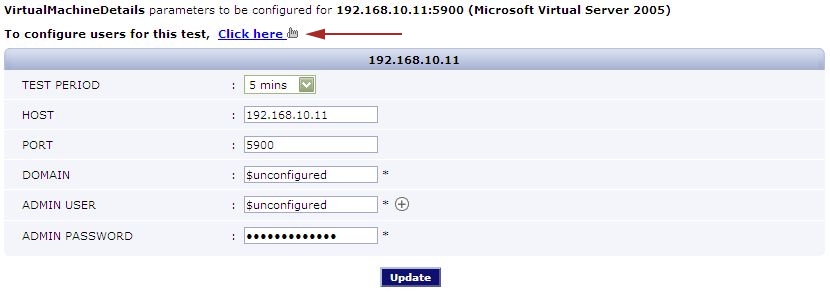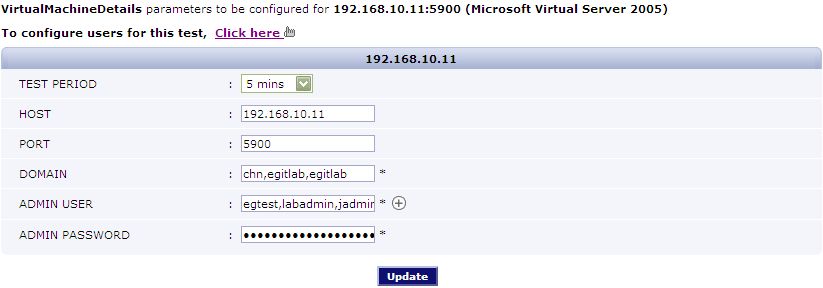Virtual Machine Details Test
This test monitors the amount of the physical server's resources that each guest on an MS Virtual server is taking up. Using the metrics reported by this test, administrators can determine which virtual guest is taking up most CPU, which guest is generating the most network traffic, which guest is taking up the maximum memory utilization, which guest has the maximum disk activity, etc. Note that the amount of resources taken up by a virtual guest will be limited by the resource allocations that have been made by administrators. For example, an administrator could cap the amount of memory that a specific guest may take.
Target of the test : A Microsoft Virtual Server
Agent deploying the test : An internal agent
Outputs of the test : One set of results for every guest to the Virtual server monitored.
| Parameter | Description |
|---|---|
|
Test period |
How often should the test be executed. |
|
Host |
The IP address of the host for which this test is to be configured. |
|
Port |
The port at which the specified host listens. |
|
Inside View Using |
By default, this test communicates with every VM remotely and extracts “inside view” metrics. Therefore, by default, the inside view using flag is set to Remote connection to VM (Windows). Typically, to establish this remote connection with Windows VMs in particular, eG Enterprise requires that the eG agent be configured with domain administrator privileges. In high-security environments, where the IT staff might have reservations about exposing the credentials of their domain administrators, this approach to extracting “inside view” metrics might not be preferred. In such environments therefore, eG Enterprise provides administrators the option to deploy a piece of software called the eG VM Agent on every Windows VM; this VM agent allows the eG agent to collect “inside view” metrics from the Windows VMs without domain administrator rights. Refer to Installing and Configuring the eG VM Agent for more details on the eG VM Agent. To ensure that the “inside view” of Windows VMs is obtained using the eG VM Agent, set the inside view using flag to eG VM Agent (Windows). Once this is done, you can set the domain, admin user, and admin password parameters to none. |
|
Domain, Admin User, Admin Password, and |
By default, this test connects to each virtual guest remotely and attempts to collect “inside view” metrics. In order to obtain a remote connection, the test must be configured with user privileges that allow remote communication with the virtual guests. The first step towards this is to specify the DOMAIN within which the virtual guests reside. The admin user and admin password will change according to the domain specification. Discussed below are the different values that the domain parameter can take, and how they impact the admin user and admin password specifications:
|
| Measurement | Description | Measurement Unit | Interpretation |
|---|---|---|---|
|
Network traffic sent |
Indicates the rate at which the guest transmitted data over the network. |
KB/Sec |
Comparing the data transmitted across all the virtual guests provides an indicator of the guest that is generating most out-bound network traffic. |
|
Network traffic received |
Indicates the rate at which the guest received data over the network. |
KB/Sec |
Comparing the data received across all the virtual guests provides an indicator of the guest that has the most in-bound network traffic. |
|
Data read from disk |
Indicates the rate at which data that was read from the disk by all IDE and SCSI controllers. |
KB/Sec |
|
|
Data written to disk |
Indicates the rate at which data was written to the disk by all IDE and SCSI controllers. |
KB/Sec |
|
|
CPU utilization |
Indicates the percentage of physical CPU used by the guest, currently. |
Percent |
A high value for this measure indicates a virtual machine that is using a lot of the processor - possibly because one or more processes on this VM are taking a lot of CPU. |
Configuring Users for VM Monitoring
In order to enable the eG agent to connect to VMs in multiple domains and pull out metrics from them, the eG administrative interface provides a special page using which the different domain names, and their corresponding admin user names and admin passwords can be specified. To access this page, just click on the Click here hyperlink in any of the VM test configuration pages.

Figure 1 : Configuring a VM test
Upon clicking, Figure 2 will appear, using which the VM user details can be configured.

Figure 2 : The VM user configuration page
To add a user specification, do the following:
- First, provide the name of the Domain to which the VMs belong (see Figure 2). If one/more VMs do not belong to any domain, then, specify none here.
- The eG agent must be configured with user privileges that will allow the agent to communicate with the VMs in a particular domain and extract statistics. If a valid Domain name has been specified, then a domain administrator account can be provided in the Admin User text box.
- The password of the specified Admin User should be mentioned in the Admin Pwd text box.
- Confirm the password by retyping it in the Confirm Pwd text box.
-
To add more users, click on the
 button in Figure 2. This will allow you to add one more user specification as depicted by Figure 3.
button in Figure 2. This will allow you to add one more user specification as depicted by Figure 3. 
-
In some virtualized environments, the same Domain could be accessed using multiple Admin User names. For instance, to login to a Domain named egitlab, the eG agent can use the Admin User name labadmin or the Admin User name jadmn. You can configure the eG agent with the credentials of both these users as shown by Figure 4.

Figure 4 : Associating a single domain with different admin users
When this is done, then, while attempting to connect to the domain, the eG agent will begin by using the first Admin User name of the specification. In the case of Figure 4, this will be labadmin. If, for some reason, the agent is unable to login using the first Admin User name, then it will try to login again, but this time using the second Admin User name of the specification – i.e., jadmin in our example (see Figure 4). If the first login attempt itself is successful, then the agent will ignore the second Admin User name.
- To clear all the user specifications, simply click the Clear button in Figure 4.
- To remove the details of a particular user alone, just click the
 button in Figure 4.
button in Figure 4. -
To save the specification, just click on the Update button in Figure 4. This will lead you back to the test configuration page, where you will find the multiple domain names, user names, and passwords listed against the respective fields (see Figure 5).

Figure 5 : The test configuration page displaying multiple domain names, user names, and passwords